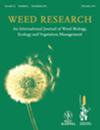台湾高粱四个分类群的地理分布及复杂的亲缘关系
IF 2.2
3区 农林科学
Q2 AGRONOMY
引用次数: 0
摘要
高粱属由25种组成,包括高粱双色(L.)全球种植的五大谷类作物之一的玉米,以及最有害的杂草之一的黑草。杂草高粱具有优异的适应性和耐旱性,在不同的环境中茁壮成长,成为世界范围内的入侵植物。台湾是一个独特的地方,有四种高粱类群,双色高粱。双色,紫紫变种,半色。黄萎病菌(verticilliflorum)和halepense,通过关键形态特征进行鉴定。4个高粱类群的地理分布明显不同,表明其入侵程度受其自身特征和人类活动的影响。栽培双色葡萄的零星分布。双色和异色可归因于人为干扰和农业活动。根茎型海葵分布广泛,遗传多样性最高(He > 0.776),对威胁台湾农业生产和生态系统的各种环境具有较强的适应性。相比之下,新归化的双色s。黄花菌主要分布在台湾南部,遗传多样性最低(He < 0.272)。遗传分化显著(FST = 0.5207)。黄萎病亚群与自然地理隔离有关。本研究具体阐明了台湾高粱入侵和逃逸类群的地理分布、遗传多样性和亲缘关系,揭示了台湾杂草高粱潜在的侵袭性和危害性。本文章由计算机程序翻译,如有差异,请以英文原文为准。
The geographic distributions and complex genetic relationships among four Sorghum taxa identified in Taiwan
The genus Sorghum consists of 25 species, including Sorghum bicolor (L.) Moench, one of the top five cereal crops cultivated globally, and S. halepense, one of the most noxious weeds. Weedy Sorghum possesses outstanding adaptability and drought tolerance thrives in diverse environments and becomes an invasive plant worldwide. Taiwan is a unique place possessing suitable habitats for four Sorghum taxa, S. bicolor ssp. bicolor, var. technicum, ssp. verticilliflorum and S. halepense, which were identified by key morphological features. The four Sorghum taxa showed distinct geographic distributions, revealing that invasiveness was influenced by their own characteristics and human activities. The sporadic distributions of cultivated S. bicolor ssp. bicolor and var. technicum may be attributed to human disturbance and agricultural activities. The rhizomatous S. halepense was widely distributed and showed the highest genetic diversity (He > 0.776) among the four taxa, with its strong adaptation to various environments threatening the agricultural practices and ecosystem in Taiwan. In contrast, the newly naturalised S. bicolor ssp. verticilliflorum was confined to and dominant in southern Taiwan, with the lowest genetic diversity (He < 0.272). Significant genetic differentiation (FST = 0.5207) between the two ssp. verticilliflorum subpopulations was associated with natural geographic isolation. This study concretely elucidated the geographic distributions, genetic diversity and relatedness of invasive and escaped Sorghum taxa, indicating the potential aggressiveness and hazard of weedy Sorghum in Taiwan.
求助全文
通过发布文献求助,成功后即可免费获取论文全文。
去求助
来源期刊

Weed Research
农林科学-农艺学
CiteScore
4.30
自引率
0.00%
发文量
41
审稿时长
12-24 weeks
期刊介绍:
Weed Research is an international peer-reviewed journal that publishes topical and innovative papers on weed science, in the English language. Its aim is to publish the best weed science from around the globe and to be the journal of choice for weed science researchers. It is the official journal of the European Weed Research Society. Papers are taken on all aspects of weeds, defined as plants that impact adversely on economic, aesthetic or environmental aspects of any system. Topics include, amongst others, weed biology and control, herbicides, invasive plant species in all environments, population and spatial biology, modelling, genetics, biodiversity and parasitic plants. The journal welcomes submissions on work carried out in any part of the world.
 求助内容:
求助内容: 应助结果提醒方式:
应助结果提醒方式:


